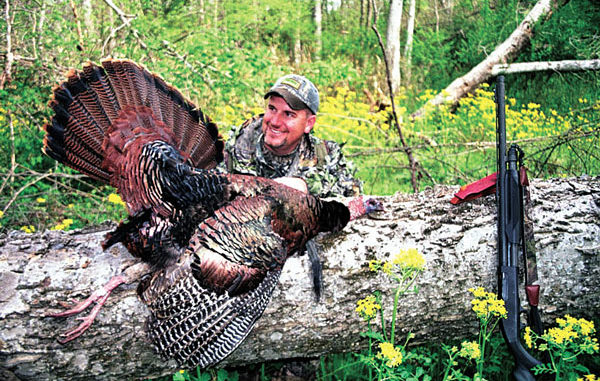
The first week is the hot one, but know how to succeed throughout the season from these experts.
If you’re serious about tagging a gobbler in South Carolina’s Upstate region, it’s important to hunt the first week of the season that begins April 1. According to data compiled by the S.C. Department of Natural Resources, hunter success is highest in that first week.
“What usually happens is that in mid-March, when the Lowcountry season opens, the gobblers are often at the peak of the mating season,” said Charles Ruth, wild-turkey project leader for SCDNR. “But when the rest of the state opens up in April, a lot of the hens are beginning to sit on their eggs, leaving gobblers alone and vulnerable to hunters. The greatest proportion of gobblers should be harvested during the first week of the season, because a high percentage of hens are nesting, and that’s certainly true in the Upstate.”
Ruth said that Upstate hunters harvest 43 percent of all gobblers are taken during the first week of the season, compared to a 27-percent harvest the first week of the early season Lowcountry framework.
The point to Upstate hunters is to be ready to get out that first week of the season, but there’s much more to success than just going; you’ve got to have a plan.
One Upstate turkey guide breaks his season into segments, and his tactics the first week are different from the remainder of the season. Jamie Pritchard from Marietta has developed a plan for success that encompasses the entire season.
Pritchard hunts a large area of the Upstate; his typical range includes Pickens, Union, and Greenville counties, but he’ll go wherever he can find cooperative gobblers.
One key to success, he said, is to be prepared to hunt that first week of the season, before the gobblers get wary of hunters and calling, but he said that by changing his tactics, he enjoys success throughout the season.
“The opening week of season is awesome, and that’s where my preseason scouting really helps,” Pritchard said. “First of all, I scout heavily throughout March so I’ll know specific areas gobblers are using by opening week. I generally know where several different gobblers will be roosting, so that helps me be in position for the first few days.”
Pritchard said that his calling technique changes after the first week. Early on, birds have not been bombarded with all sorts of calls and are more responsive to more aggressive calling.
“Actually, as each week goes by, I reduce my calling in terms of how aggressive and often I call,” he said. “The first week, I want to get the gobblers excited and responsive, so I’ll call more. Plus, having patterned them, I’ll have a good idea of which direction they want to go when they fly down. So one tactic is to get set up between the roost and the direction I believe they would travel anyway. It’s much easier to call a bird in that already wants to come in your direction.”
Pritchard will use a mouth call almost exclusively early in the season, but later on, he will also use a friction call or two.
“I’ll begin to mix up the calls later on in the season as I tone down my aggressiveness,” Pritchard said. “As gobblers get used to calls from me and other hunters, the need to have slightly different sounds is important. I also use a crystal friction call, and sometimes in the afternoons, I will mix in a box call as well. I’ve learned that call-wary gobblers are easy to overcall later in the season, so once I get his attention, I’ll call sparingly and sometimes use a heavy dose of silence and some scratching in the leaves to coax him to the gun.”
Pritchard said one of his favorite places to hunt in the Upstate is the mountains. It can be labor-intensive getting back into good areas in terms of walking, but great advantages exist.
“First of all, as far as I’m concerned, the turkeys gobble a lot more in the mountains and will really gobble all the way in and put on a fantastic show,” Pritchard said. “It does require some walking to get back into some of the best areas, but even on public land, some of the isolated areas will produce great opportunities throughout the season. If I have a client who really wants to hear gobbling and have a bird put on a real show, then we’re off to the mountain territory. We’ll work the ridges and utilize logging roads a lot to hunt these areas.”
“I’m not saying mountain birds are easy in terms of being foolish. They are just as wary as Piedmont gobblers,” he said. “But if you slip in and get set up properly on a mountain gobbler, the gobbling and strutting show you can witness is awesome. Plus, they are more receptive to aggressive calling than Piedmont birds later in the season. Maybe there’s less pressure on them where I hunt, but I can be more aggressive when calling the bird, which certainly makes the hunt more exciting”
Pritchard said that while his overall style is more of a patient one in terms of setting up and calling from good locations, he will often do more stalking and calling in the mountains trying to strike a gobbler.
“In the mountains, I do walk and call, covering territory,” he said, “but as in the Piedmont area, if I find a place loaded with fresh turkey sign and have an excellent setup for calling, I’ll often set up and call from a single location for a while. Many times, I’ll work gobblers this way, and while the Piedmont birds will occasionally slip in quietly during mid-day, the mountain birds generally gobble as they approach throughout the day.”
Travis Sumner of Edgefield is another excellent hunter who loves the Upstate. A former guide and SCDNR biologist, he now works as a wildlife-management specialist for a consulting firm.
“One of the most difficult tasks any hunter can embark on is to try to harvest a mature wild turkey in the Upstate.” Sumner said. “There’s such a diversity of habitat, and as the weeks of the season change, so do their habits. As the hens begin nesting, the gobblers also change their patterns, but there are things hunters can do to cope with changes in turkey patterns.
“There are specific places where I love to intercept a gobbler,” he said. “One is an open area like a powerline, and another is a food plot. A powerline planted in a food plot is an awesome combination. It’s a great mid-morning and afternoon place to set up. If birds are roosted nearby, it’s an ideal early morning setup as well. Another great place is creekbottoms. Not only are they beautiful places in April, they are full of gobblers.”
Sumner said he likes to walk and call to locate gobblers if he doesn’t get on one early off the roost.
“If I’m not successful on a roosted bird, I start moving and calling as I go,” Sumner said. “I’ll mix up my calls using mouth, slate, box and tube calls. I keep giving the gobbler different sounds until he hears what he likes or I finally just get close enough to get his interest.
“I try to set up in shady areas when possible. Also I’ll use limbs, brush and other material to help blend in when setting up on a gobbler, especially if one gobbles mid-day and I don’t have time to pick the perfect setup.
“From mid-morning to early afternoon, this is a favorite technique and frankly, one of the better times of the day to harvest a gobbler in the Upstate area,” Sumner said.

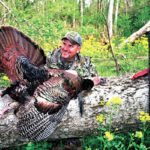
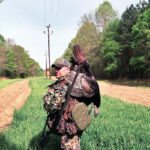
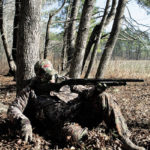
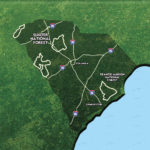
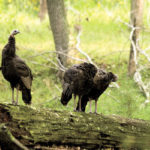
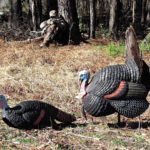



Be the first to comment